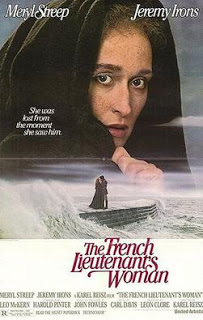
Written by: Harold Pinter
Starring: Meryl Streep, Jeremy Irons, David Warner, Hilton McRae, Emily Morgan
Rating: [4/5]
Art has a funny way of imitating life at times, where things, in reality, can play out the same way as some novel. A storytelling method The French Lieutenant’s Woman uses to its advantage in the way it blends and combines two narratives where it becomes difficult to pull them apart. Fused together, this feature shows the optimism of fiction versus the harsh reality of the real world in such a luscious manner.
Starring in a feature film production together Anna (Meryl Streep) and Mike (Jeremy Irons) share an extramarital affair together when in-between their takes. Concurrently, the characters they portray in the film, Miss Sarah Woodruff and Charles Henry Smithson engage in a similar scandalous engagement with the narrative jumping back and forth between the two stories.
Starting out like any old period piece would, the surprise of the narrative twist in The French Lieutenant’s Woman truly makes for such a fascinating trip on the power of storytelling and the way it merges with life. Many Hollywood relationships have started from meeting onset and the work is collectively done driving the passion to get them involved romantically. The scandal of it all comes from at times both parties not being single when the romantic engagement occurs. This is where both Anna and Mike find themselves as the passion they feel when performing as these two characters bleed over to their personal lives. Having never been an actor, I cannot speak to how this occurs, but it makes sense when these thespians try to become these characters and in the process connect with their colleagues in a way no others could.
In this feature, the narrative taking place between the actors and their characters within the film mirror each other well to display how their perceived relationships get seen by the contemporaries and it goes the way you probably suspect. Most of the runtime gets dedicated to the film within the film as it displays the story of Charles Smithson and how he gets engaged to a connected young woman. Getting the father’s approval as well makes for the perfect marriage for this attorney, which all gets railed when he meets Sarah Woodruff. Shamed due to what the title suggests, she essentially walks around with a scarlet letter on her forehead due to the puritanical nature of society during that time. Upon their first meeting, Charles simply becomes captivated by her, and even with the societal pressures for him to treat her like an outcast, he simply cannot do it. They form a friendship and then a romantic bond, where Charles is willing to risk it all in order to be with her.
Similarly, with the actors, Anna and Mike have this flourishing romantic relationship while on set where they practice their lines with each other and make love in between. The scandal existent between Charles and Sarah does not come close to the fairly open secret on set about their relationship. The other crew and cast members know of their marriages but seemingly turn a blind eye to them and their relationship as no shame exists in this space, which could not be said the same for Charles and Sarah. Each time Charles interacts with her, it becomes the town gossip for the reputation she has built, showing a man’s fall from grace in order to find a love he could never have with his current fiancee.
The way the screenplay and direction marry the two stories works wonders and brilliantly allow this story to flourish. When emotional beats strike in one narrative, it shows how different it looks in the other. Even with the more dramatic component of the film within this film, the way it correlates with the actors’ story works so seamlessly. Certainly, a tightrope to walk and the way it all concludes makes complete sense for what these stories represent. Sets in one story represent an important component of the other and words said within the story crossover to reality in the way these two speak together. The only real difference lies in the costume design of each, which serves as a testament to the unequivocal success of this film.
Two legendary actors covering two roles each, the combination of Streep and Irons proved to be quite the treat. Both roles fairly early in their careers and with Streep fresh off her Academy Award-winning performance in Kramer vs. Kramer, their combined work shows the range they can imbue into each character. As actors portraying actors, they show exactly what they need to when necessary and hide whatever needs to be tucked away in an emotional sense. They demonstrate very early just how much talent they have and it certainly stands out in the experience of watching this film.
Narratively thrilling and enjoyable, The French Lieutenant’s Woman plays with a double narrative better than many films do with just one. It marries both stories to tell a complete one about the limitations of love and what the individuals involved are willing to in order to maintain it. Having it play out both in modern times and in a period piece allows for some fun contrasts but ultimately shows how this message hits home no matter what era we’re living in thus making it universal.

